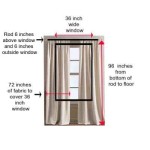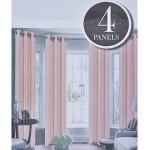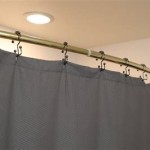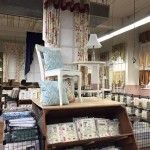Front Door Sidelight Panel Curtains: Enhancing Privacy, Light Control, and Aesthetics
Front door sidelights, the narrow vertical windows flanking the entrance door, are architectural features designed to introduce natural light into the entryway. However, these sidelights often present challenges regarding privacy, unwanted glare, and temperature control. Front door sidelight panel curtains offer a practical and aesthetically pleasing solution to these issues, providing a customizable means to manage light infiltration, preserve privacy, and enhance the overall appearance of the entrance.
The market offers a diverse range of sidelight curtains, catering to various functional needs and design preferences. Selection requires careful consideration of factors such as fabric type, opacity, mounting mechanisms, and overall style to achieve the desired outcome. These curtains can dramatically transform the functionality and aesthetics of an entryway, contributing to a more comfortable and visually appealing home.
Key Considerations When Selecting Sidelight Curtains
Choosing the appropriate sidelight curtains involves evaluating several critical factors to ensure that the chosen solution effectively addresses privacy, light control, and aesthetic concerns. A thorough understanding of these elements is crucial for making an informed decision that aligns with individual needs and preferences.
1. Fabric Type and Opacity: The fabric used in sidelight curtains significantly influences the amount of light that penetrates the window and the level of privacy afforded. Opaque fabrics, such as blackout linings, provide complete privacy and block out sunlight effectively, ideal for those seeking maximum seclusion or temperature regulation. Sheer fabrics, conversely, allow ample light to filter through while offering a degree of privacy. These are suitable for individuals who wish to maintain natural light levels but mitigate direct visibility into the home. Semi-sheer fabrics strike a balance between these two extremes, providing a moderate level of privacy and light diffusion. The choice of fabric should correlate with the desired level of privacy and light control.
Beyond opacity, the texture and material of the fabric contribute to the aesthetic appeal of the curtains. Linen offers a natural, textured look, while silk or velvet introduces a touch of luxury and elegance. Synthetic fabrics such as polyester are durable and easy to maintain, making them a practical choice for high-traffic areas. Considering the overall décor and desired ambiance is essential when selecting the fabric type.
2. Mounting Mechanisms and Hardware: The method of attaching sidelight curtains to the door frame is another crucial consideration. Several options are available, each with its own advantages and disadvantages. Tension rods offer a simple and non-invasive solution, suitable for renters or those seeking a quick and easy installation. These rods are adjustable and fit snugly within the window frame, holding the curtains in place without the need for drilling or hardware. However, tension rods may not be suitable for heavier fabrics or frequently adjusted curtains.
Magnetic rods provide another drill-free option, utilizing magnets to adhere to metal door frames. This method is convenient for steel doors and offers a clean, minimalist look. However, the strength of the magnets may vary, and they may not be compatible with non-metal door frames. Traditional curtain rods with brackets require drilling into the door frame, providing a more secure and permanent installation. This method is suitable for heavier fabrics and offers a wider range of styling options, but it necessitates more effort during installation. Regardless of the chosen mechanism, ensuring that the hardware complements the curtains and door frame is vital for a cohesive aesthetic.
3. Style and Design Considerations: Sidelight curtains are available in a wide array of styles and designs, ranging from simple panels to more elaborate treatments. The chosen style should complement the existing décor and architectural style of the home. For a modern or minimalist aesthetic, simple, unadorned panels in neutral colors are often the best choice. These curtains offer a clean and streamlined look, blending seamlessly with the surrounding environment.
For more traditional or elaborate décor, pleated or gathered curtains in richer fabrics and colors may be more appropriate. These curtains add a touch of elegance and sophistication to the entryway. Consider the overall design of the room and select curtains that complement the existing color palette and patterns. Adding decorative elements such as tiebacks, valances, or trims can further enhance the look of the curtains and add a personal touch.
Benefits of Installing Sidelight Curtains
The installation of sidelight curtains extends beyond mere aesthetics, providing several practical benefits that enhance the comfort, security, and energy efficiency of the home. These advantages make sidelight curtains a worthwhile investment for any homeowner.
1. Enhanced Privacy and Security: One of the primary benefits of sidelight curtains is the enhanced privacy they provide. By blocking direct views into the home, these curtains deter potential intruders and create a sense of security. This is particularly important for homes located on busy streets or in densely populated areas. Opaque or blackout curtains offer the highest level of privacy, while sheer or semi-sheer curtains provide a degree of privacy while still allowing natural light to enter. Choosing the appropriate opacity level depends on individual privacy needs and preferences.
Furthermore, sidelight curtains can obscure valuable items within the home from prying eyes, further deterring potential theft. By preventing outsiders from seeing inside, these curtains add an extra layer of security and peace of mind. The addition of automated or motorized sidelight curtains can further enhance security, allowing homeowners to control the curtains remotely and simulate occupancy when they are away.
2. Improved Light Control and Glare Reduction: Sidelight curtains effectively control the amount of sunlight entering the entryway, reducing glare and preventing damage to furniture and flooring. Excessive sunlight can fade upholstery, warp wooden furniture, and damage delicate items. By filtering or blocking sunlight, sidelight curtains protect these items and prolong their lifespan. Sheer or semi-sheer curtains diffuse sunlight, creating a soft and inviting ambiance while minimizing harsh glare.
Blackout curtains offer the ultimate in light control, completely blocking out sunlight and creating a dark and comfortable environment. This is particularly beneficial for individuals who are sensitive to light or who work night shifts and need to sleep during the day. The ability to adjust the amount of light entering the entryway allows homeowners to create a more comfortable and functional living space.
3. Increased Energy Efficiency and Temperature Regulation: Sidelight curtains contribute to energy efficiency by helping to regulate the temperature inside the home. During the summer months, curtains can block out sunlight, preventing heat from entering the home and reducing the need for air conditioning. This can result in significant energy savings and lower utility bills. In the winter months, curtains can help to insulate the entryway, preventing heat from escaping and reducing the need for heating. This can also lead to energy savings and lower heating costs.
The choice of fabric can further enhance the energy efficiency of sidelight curtains. Thicker fabrics, such as those with thermal linings, provide better insulation than thinner fabrics. Blackout curtains, in particular, are effective at blocking out heat and cold, making them a valuable addition to any home seeking to reduce energy consumption. By helping to regulate temperature, sidelight curtains create a more comfortable and energy-efficient living environment.
Maintenance and Care of Sidelight Curtains
Proper maintenance and care are essential for prolonging the lifespan and maintaining the appearance of sidelight curtains. Regular cleaning and appropriate care techniques will keep the curtains looking their best and functioning optimally.
1. Regular Cleaning and Dusting: Dust and dirt can accumulate on sidelight curtains over time, dulling their appearance and potentially damaging the fabric. Regular dusting or vacuuming is essential for removing this buildup and maintaining the curtains' cleanliness. A handheld vacuum with a brush attachment is ideal for removing dust and debris. Alternatively, a soft cloth or duster can be used to gently wipe down the curtains. The frequency of cleaning will depend on the environment and the amount of dust and dirt present.
For curtains that are exposed to high levels of dust or allergens, more frequent cleaning may be necessary. Consider using a hypoallergenic detergent when washing curtains to minimize the risk of allergic reactions. Avoid using harsh chemicals or abrasive cleaners, as these can damage the fabric and fade the colors.
2. Washing and Drying Instructions: Before washing sidelight curtains, always check the manufacturer's instructions for specific care recommendations. Some fabrics may require dry cleaning, while others can be machine washed. If machine washing is permitted, use a gentle cycle and cold water to minimize the risk of shrinking or fading. Place the curtains in a laundry bag to protect them from damage during the wash cycle. Use a mild detergent designed for delicate fabrics.
After washing, tumble dry the curtains on low heat or hang them to air dry. Avoid using high heat, as this can cause the fabric to shrink or wrinkle. If ironing is necessary, use a low setting and iron the curtains on the reverse side to prevent damage. Be sure to follow the manufacturer's instructions carefully to avoid damaging your curtains.
3. Addressing Stains and Repairs: Stains should be addressed promptly to prevent them from setting and becoming difficult to remove. Blot the stain with a clean, damp cloth, working from the outside in to prevent it from spreading. Avoid rubbing the stain, as this can damage the fabric. Use a mild stain remover specifically designed for the type of fabric. Test the stain remover on an inconspicuous area of the curtain before applying it to the stain to ensure that it does not cause any discoloration or damage.
Minor repairs, such as loose seams or torn hems, should be addressed promptly to prevent them from worsening. Use a needle and thread that matches the color of the fabric to repair the damage. If you are not comfortable making the repairs yourself, consider taking the curtains to a professional tailor or seamstress. Regular maintenance and timely repairs will help to prolong the lifespan of your sidelight curtains and keep them looking their best.

Sheer Door Curtain Sidelight Window French Curtains Front Patio Cottage Etsy

Sheer Sidelight Curtain Fits Windows Between 5 To 13 Wide Custom Made Curtains Single Panel Etsy

Sheer Linen Look Sidelight Curtain Single Panel Semi Privacy

72 X26 Seymour Energy Efficient Front Door Sidelight Curtain Panel Gray Sun Zero Room Darkening French

Sheer Door Curtain Sidelight Window French Curtains Front Patio Cottage Etsy

Nicetown Sidelight Curtains For Front Door 72 Inches Long Faux Linen Blackout Thermal Insulated Rod Pocket Curtain Panel 25 X72 Angora 1

Liz Claiborne Lisette Sheer Rod Pocket Single Sidelight Curtains Beige One Size Drapes

Sidelight Curtains Plaid Selection Single Panel

Clearance 10 W X 63 L Light Gray Sidelight Curtain No Blackout Returns Etsy

1 Panel Front Door Curtain Window Drapes Blackout For Sidelights Privacy Protect French








